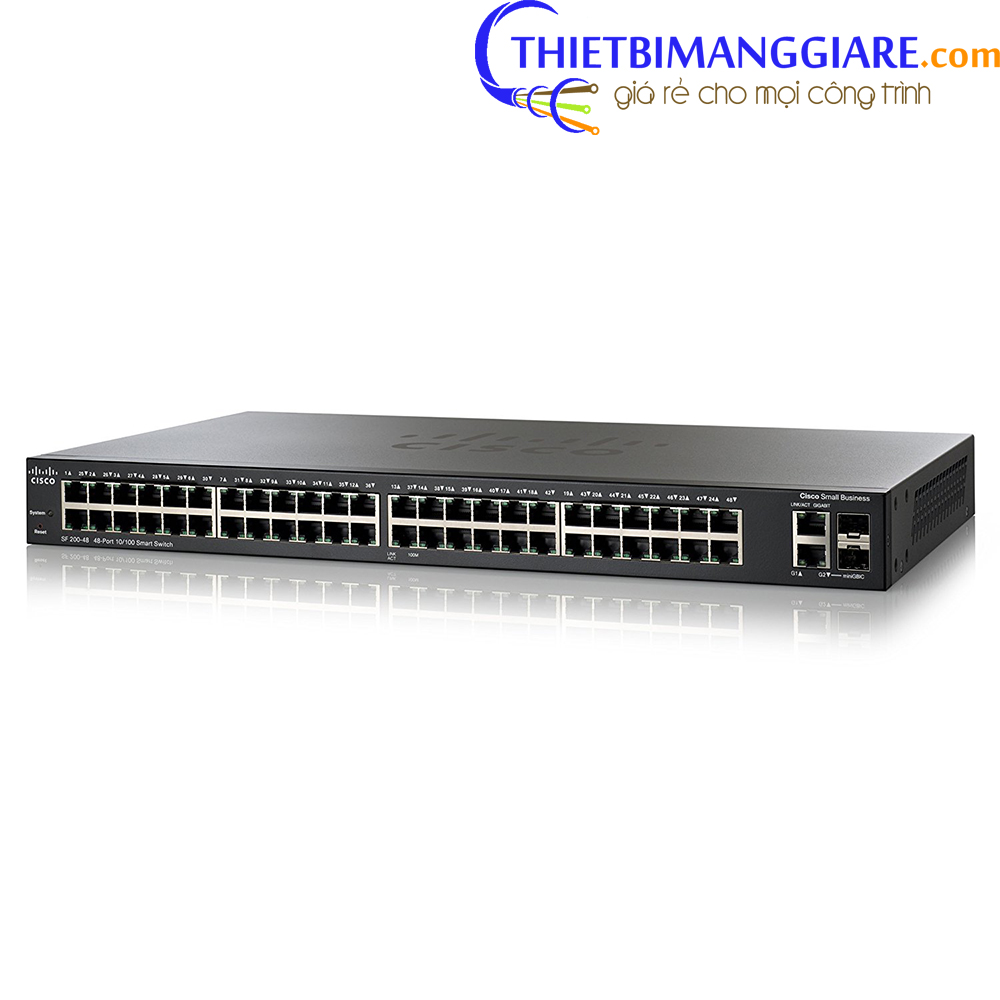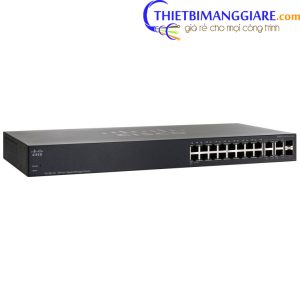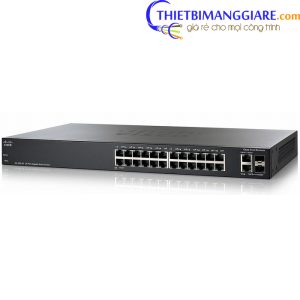Switch chia mạng Cisco 50Port 10/100/1000Mbps – Cisco SG200-50
Switch chia mạng Cisco 50Port 10/100/1000Mbps – Cisco SG200-50 là một thiết bị quan trọng dùng để kết nối các đoạn mạng với nhau theo mô hình mạng hình sao (Star). Theo mô hình này, switch đóng vai trò là thiết bị trung tâm, tất cả các máy tính đều được nối về đây trong một hệ thống mạng
Switch chia mạng Cisco 50 Port 10/100/1000Mbps – Cisco SG200-50
Giới thiệu chung
Switch chia mạng Cisco 50Port 10/100/1000Mbps – Cisco SG200-50 là một thiết bị quan trọng dùng để kết nối các đoạn mạng với nhau theo mô hình mạng hình sao (Star). Theo mô hình này, switch chia mạng đóng vai trò là thiết bị trung tâm, tất cả các máy tính đều được nối về đây trong một hệ thống mạng
Tính năng switch mạng Cisco 50Port 10/100/1000Mbps – Cisco SG200-50
– Part number: SLM2048T-EU
– 48 cổng 10/100/1000Mbps tự động chuyển chế độ cáp thẳng hoặc chéo (MDI/MDI-X) + 2 combo mini-GBIC ports
– Hoạt động ở 2 chế độ half- or full-duplex cho mỗi cổng
– Thiết kế để bàn hoặc lắp trên tủ Rack
– Address Learning and Aging, and Data Flow Control giúp tối ưu truyền dữ liệu
– Nguồn điện: 110-240VAC, 50-60 Hz, internal
Cisco 50Port 10/100/1000Mbps – Cisco SG200-50 hiệu suất cao và sử dụng công nghệ tiên tiến
– Hỗ trợ cho các công nghệ tiên tiến: Tất cả các thiết bị chuyển mạch Cisco bao gồm các tính năng giao thông xử lý tiên tiến để giữ cho các ứng dụng chạy ở hiệu suất cao điểm.
– Tích hợp QoS thông minh trên tất cả các mô hình tự động ưu tiên dịch vụ chậm trễ nhạy cảm như thoại hoặc video để cải thiện hiệu suất mạng.
– Fast store-and-forward switching xác định các gói tin bị hư hỏng và ngăn ngừa chúng khỏi bị truyền qua mạng. Tất cả những tính năng chạy tự động, không có quản lý hoặc cấu hình yêu cầu
– Cisco 50Port 10/100/1000Mbps – Cisco SG200-50 mang hiệu suất mà cao để chạy các ứng dụng viễn thông, bao gồm cả các dịch vụ video băng thông. Nâng cao công suất và hiệu suất truyền tải, cho phép bạn chuyển các tập tin lớn trong vài giây
Thông số kỹ thuật
|
Performance |
|
|
Standards |
IEEE 802.3 10BASE-T Ethernet |
| IEEE 802.3u 100BASE-TX Fast Ethernet | |
| IEEE 802.3ab 1000BASE-T Gigabit Ethernet | |
| IEEE 802.3ad LACP | |
| IEEE 802.3z Gigabit Ethernet | |
| IEEE 802.3x Flow Control | |
| IEEE 802.1D (STP) | |
| IEEE 802.1Q/p VLAN | |
| IEEE 802.1w RSTP | |
| IEEE 802.1X Port Access Authentication | |
| IEEE 802.3af | |
| RFC 768, RFC 783, RFC 791, RFC 792, RFC 793, RFC 813, RFC 879, RFC 896, RFC 826, RFC 854, RFC 855, RFC 856, RFC 858, RFC 894, RFC 919, RFC 922, RFC 920, RFC 950, RFC 951, RFC 1042, RFC 1071, RFC 1123, RFC 1141, RFC 1155, RFC 1350, RFC 1533, RFC 1541, RFC 1542, RFC 1624, RFC 1700, RFC 1867, RFC 2030, RFC 2616, RFC 2131, RFC 2132, RFC 3164, RFC 3411, RFC 3412, RFC 3413, RFC 3414, RFC 3415, RFC 2576, RFC 4330, RFC 1213, RFC 1215, RFC 1286, RFC 1442, RFC 1451, RFC 1493, RFC 1573, RFC 1643, RFC 1757, RFC 1907, RFC 2011, RFC 2012, RFC 2013, RFC 2233, RFC 2618, RFC 2665, RFC 2666, RFC 2674, RFC 2737, RFC 2819, RFC 2863, RFC 1157, RFC 1493, RFC 1215, RFC 3416 | |
|
Protocols |
TCP/IP |
|
Layer 2 Switching |
Spanning Tree: |
| Standard 802.1d STP support | |
| Fast convergence using 802.1w (Rapid Spanning Tree [RSTP]), enabled by default | |
| Port Grouping: | |
| Support for IEEE 802.3ad Link Aggregation Control Protocol (LACP) | |
| ·Up to 4 groups | |
| ·Up to 4 ports per group with 16 candidate ports for each (dynamic) 802.3ad link aggregation | |
| VLAN: | |
| Support for up to 128 VLANs simultaneously (out of 4096 VLAN IDs) | |
| Port-based and 802.1Q tag-based VLANs | |
| Voice VLAN: | |
| Voice traffic is automatically assigned to a voice-specific VLAN and treated with appropriate levels of QoS | |
| Internet Group Management Protocol (IGMP) Versions 1 and 2 Snooping: | |
| IGMP limits bandwidth-intensive multicast traffic to only the requesters; supports 256 multicast groups | |
| Head-of-Line (HOL) blocking: | |
| HOL blocking prevention | |
|
Security |
IEEE 802.1X (Authenticator Role): |
| 802.1X: RADIUS authentication and accounting, MD5 hash | |
| Supports time-based 802.1X | |
| Dynamic VLAN assignment | |
| Port Security: | |
| Locks MAC addresses to ports, and limits the number of learned MAC addresses | |
| Storm Control: | |
| Broadcast, multicast, and unknown unicast | |
|
Quality of Service |
Priority Levels: |
| 4 hardware queues | |
| Scheduling: | |
| Strict priority and weighted round-robin (WRR) | |
| Queue assignment based on differentiated services code point (DSCP) and class of service (802.1p/CoS) | |
| Class of Service: | |
| Port based, 802.1p VLAN priority based, IPv4/v6 IP precedence/type of service (ToS)/DSCP based, Differentiated Services (DiffServ) | |
| Rate Limiting: | |
| Ingress policer, per VLAN, and per port | |
|
IPv6 |
IPv6: |
| IPv6 host mode | |
| IPv6 over Ethernet | |
| Dual IPv6/IPv4 stack | |
| IPv6 neighbor and router discovery (ND) | |
| IPv6 stateless address auto-configuration | |
| Path maximum transmission unit (MTU) discovery | |
| Duplicate address detection (DAD) | |
| Internet Control Message Protocol (ICMP) version 6 | |
| IPv6 over IPv4 network with Intra-Site Automatic Tunnel Addressing Protocol (ISATAP) support | |
| IPv6 QoS | |
| Prioritize IPv6 packets in hardware | |
| Multicast Listener Discovery (MLD) Snooping: | |
| Deliver IPv6 Multicast Packets only to the Required Receivers | |
| IPv6 Applications: | |
| Web, ping, Simple Network Time Protocol (SNTP), Trivial File Transfer Protocol (TFTP), RADIUS, syslog, DNS client | |
| IPv6 RFCs Supported: | |
| RFC 2463: ICMP version 6 | |
| RFC 3513: IPv6 address architecture | |
| RFC 4291: IPv6 addressing architecture | |
| RFC 2460: IPv6 specification | |
| RFC 2461: Neighbor discovery for IPv6 | |
| RFC 2462: IPv6 stateless address auto-configuration | |
| RFC 1981: Path maximum transmission unit (MTU) discovery | |
| RFC 4007: IPv6 scoped address architecture | |
| RFC 3484: Default address selection mechanism | |
| RFC 4214: ISATAP tunneling | |
| RFC 4293: MIB IPv6: Textual conventions and general group | |
| RFC 3595: Textual conventions for IPv6 flow label | |
|
Management |
Web User Interface |
| Remote Monitoring (RMON) | |
| IPv4 and IPv6 | |
| Firmware upgrade | |
| Port mirroring | |
| VLAN mirroring | |
| DHCP (Options 66 and 67) | |
| Text-editable config files | |
| Smartports | |
| Cloud services | |
| Localization | |
| Other management: HTTP, RADIUS, port mirroring, TFTP upgrade, DHCP client, BOOTP, SNTP, ping, syslog | |
|
Power Management |
Energy Detect |
| Cable length detection | |
|
MAC Address Table Size |
Up to 8000 MAC addresses |
|
Frame Size |
Frame sizes up to 10KB supported |
|
Ports |
50x Total Ports |
| 48x RJ-45 10/100/1000 Ethernet Ports | |
| 2x RJ-45 10/100/1000 and SFP Combo Ports | |
|
Buttons |
Reset Button |
|
Cable |
Requires: |
| Unshielded twisted pair (UTP) Category 5 or better for 10BASE-T/100BASE-TX; UTP Category 5 Ethernet or better for 1000BASE-T | |
|
LEDs |
System, Link/Act, PoE, Speed |
|
Buffer |
Packet Buffer: |
| 2 @ 8Mb | |
|
Fan |
2x |
|
Acoustic Noise |
41.7 dB |
|
MTBF |
237,610 hours @ 40°C |
|
General |
|
|
Form Factor |
1U Rack mount |
|
System Requirements |
Minimum: |
| ·Web browser: Mozilla Firefox version 2.5 or later; Microsoft Internet Explorer version 6 or later | |
| ·: center;”>Certifications | UL (UL 60950), CSA (CSA 22.2), CE mark, FCC Part 15 (CFR 47) Class |
|
Power Requirements |
110V to 240V, 12V/8.33A, 50 to 60HZ |
|
Power Consumption |
Up to 110V/0.569A/61.8W and 220V/0.296A/61.4W |
|
Dimensions (WxHxD) |
17.35 x 1.73 x 10.1′ / 44 x 4.4 x 25.7 cm |
|
Weight |
8.73 lb / 3.96kg |




 Ms. Dung – 0982 960 685
Ms. Dung – 0982 960 685












Reviews
There are no reviews yet.